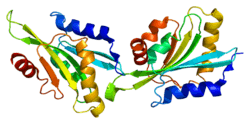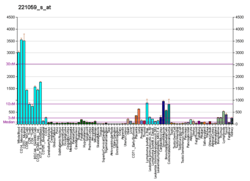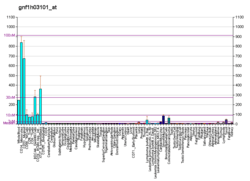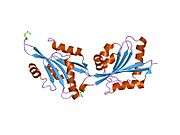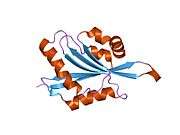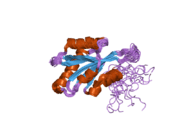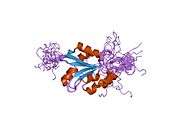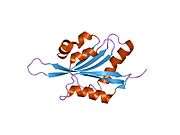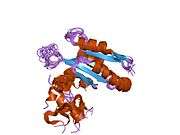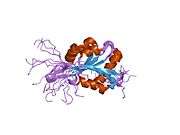Function
This gene encodes one of the numerous actin-binding proteins which regulate the actin cytoskeleton. This protein binds F-actin, and also interacts with and thereby stabilizes 5-lipoxygenase (ALOX5). Although this gene has been reported to map to chromosome 17 in the Smith-Magenis syndrome region, the best alignments for this gene are to chromosome 16. The Smith-Magenis syndrome region is the site of two related pseudogenes.[8]
References
- 1 2 3 GRCh38: Ensembl release 89: ENSG00000103187 - Ensembl, May 2017
- 1 2 3 GRCm38: Ensembl release 89: ENSMUSG00000031827 - Ensembl, May 2017
- ↑ "Human PubMed Reference:".
- ↑ "Mouse PubMed Reference:".
- ↑ Provost P, Samuelsson B, Rådmark O (Apr 1999). "Interaction of 5-lipoxygenase with cellular proteins". Proc. Natl. Acad. Sci. U.S.A. 96 (5): 1881–5. doi:10.1073/pnas.96.5.1881. PMC 26705. PMID 10051563.
- ↑ Chen KS, Manian P, Koeuth T, Potocki L, Zhao Q, Chinault AC, Lee CC, Lupski JR (Nov 1997). "Homologous recombination of a flanking repeat gene cluster is a mechanism for a common contiguous gene deletion syndrome". Nat. Genet. 17 (2): 154–63. doi:10.1038/ng1097-154. PMID 9326934.
- ↑ Rakonjac M, Fischer L, Provost P, Werz O, Steinhilber D, Samuelsson B, Rådmark O (Sep 2006). "Coactosin-like protein supports 5-lipoxygenase enzyme activity and up-regulates leukotriene A4 production". Proc. Natl. Acad. Sci. U.S.A. 103 (35): 13150–5. doi:10.1073/pnas.0605150103. PMC 1559768. PMID 16924104.
- 1 2 "Entrez Gene: COTL1 coactosin-like 1 (Dictyostelium)".
- ↑ Provost P, Doucet J, Hammarberg T, Gerisch G, Samuelsson B, Radmark O (May 2001). "5-Lipoxygenase interacts with coactosin-like protein". J. Biol. Chem. 276 (19): 16520–7. doi:10.1074/jbc.M011205200. PMID 11297527.
- ↑ Anwar Y, Sabir JS, Qureshi MI, Saini KS (2014). "5-lipoxygenase: a promising drug target against inflammatory diseases-biochemical and pharmacological regulation". Current Drug Targets. 15 (4): 410–22. doi:10.2174/1389450114666131209110745. PMID 24313690.
Further reading
- Wu C, Friedlander P, Lamoureux C, Zannis-Hadjopoulos M, Price GB (1993). "cDNA clones contain autonomous replication activity". Biochim. Biophys. Acta. 1174 (3): 241–57. doi:10.1016/0167-4781(93)90193-h. PMID 7690594.
- Provost P, Doucet J, Hammarberg T, Gerisch G, Samuelsson B, Radmark O (2001). "5-Lipoxygenase interacts with coactosin-like protein". J. Biol. Chem. 276 (19): 16520–7. doi:10.1074/jbc.M011205200. PMID 11297527.
- Provost P, Doucet J, Stock A, Gerisch G, Samuelsson B, Rådmark O (2001). "Coactosin-like protein, a human F-actin-binding protein: critical role of lysine-75". Biochem. J. 359 (Pt 2): 255–63. doi:10.1042/0264-6021:3590255. PMC 1222143. PMID 11583571.
- Nakatsura T, Senju S, Ito M, Nishimura Y, Itoh K (2002). "Cellular and humoral immune responses to a human pancreatic cancer antigen, coactosin-like protein, originally defined by the SEREX method". Eur. J. Immunol. 32 (3): 826–36. doi:10.1002/1521-4141(200203)32:3<826::AID-IMMU826>3.0.CO;2-Y. PMID 11870627.
- Gevaert K, Goethals M, Martens L, Van Damme J, Staes A, Thomas GR, Vandekerckhove J (2003). "Exploring proteomes and analyzing protein processing by mass spectrometric identification of sorted N-terminal peptides". Nat. Biotechnol. 21 (5): 566–9. doi:10.1038/nbt810. PMID 12665801.
- Dai H, Wu J, Xu Y, Yajun T, Husheng D, Shi Y (2004). "1H, 13C and 15N resonance assignments and the secondary structures of human coactosin like protein (hCLP) D123N". J. Biomol. NMR. 29 (3): 455–6. doi:10.1023/B:JNMR.0000032550.18424.aa. PMID 15213466.
- Liu L, Wang Y, Zhang P, Cheng Z, Wan M, Zhou Z, Gong W (2004). "Expression, purification and preliminary crystallographic studies of human coactosin-like protein". Acta Crystallogr. D. 60 (Pt 9): 1651–3. doi:10.1107/S0907444904016701. PMID 15333945.
- Li X, Liu X, Lou Z, Duan X, Wu H, Liu Y, Rao Z (2004). "Crystal structure of human coactosin-like protein at 1.9 A resolution". Protein Sci. 13 (11): 2845–51. doi:10.1110/ps.04937304. PMC 2286586. PMID 15459340.
- Li X, Liu X, Zhao Q, Liu Y, Duan X, Rao Z (2004). "Crystallization and preliminary crystallographic studies of human coactosin-like protein (CLP)". Acta Crystallogr. D. 60 (Pt 12 Pt 2): 2387–8. doi:10.1107/S0907444904028112. PMID 15583396.
- Gevaert K, Staes A, Van Damme J, De Groot S, Hugelier K, Demol H, Martens L, Goethals M, Vandekerckhove J (2005). "Global phosphoproteome analysis on human HepG2 hepatocytes using reversed-phase diagonal LC". Proteomics. 5 (14): 3589–99. doi:10.1002/pmic.200401217. PMID 16097034.
- Dai H, Huang W, Xu J, Yao B, Xiong S, Ding H, Tang Y, Liu H, Wu J, Shi Y (2006). "Binding model of human coactosin-like protein with filament actin revealed by mutagenesis". Biochim. Biophys. Acta. 1764 (11): 1688–700. doi:10.1016/j.bbapap.2006.06.017. PMID 17070122.
PDB gallery |
|---|
1t2l: Three Crystal Structures of Human Coactosin-like Protein 1t3x: Three Crystal Structures of Human Coactosin-like Protein 1t3y: Three Crystal Structures of Human Coactosin-like Protein 1tmw: Solution structure of Human Coactosin Like Protein D123N 1udm: Solution structure of Coactosin-like protein (Cofilin family) from Mus Musculus 1vfq: The Crystal Structure of Human Coactosin-like Protein at 1.9 A Resolution 1wm4: Solution structure of mouse coactosin, an actin filament binding protein 1wnj: NMR structure of human coactosin-like protein |
